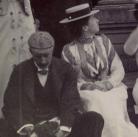Road to Women's Suffrage Timeline
Created by Laura Rotunno on Mon, 07/23/2018 - 15:25
Part of Group:
Here you will find an INFORMATIVE timeline that will help us (and perhaps other students who may use COVE) flesh out the events that led to some British women gaining voting rights in 1918.
Timeline
Chronological table
| Date | Event | Created by | Associated Places | |
|---|---|---|---|---|
| 28 Feb 1912 |
Violet Markham's Speech at Royal Albert HallOn February 28, 1912, Violet Markham gave a speech where she explained how the women who were claiming the parliamentary suffrage were ignoring other opportunities that the law has already given them. As a member of the Women's National Anti- Suffrage Leauge member Markham addressed an anti-suffrage meeting at the Royal Albert Hall where she gave a speech about the women's suffrage movement claiming that "men and women are different- not similar- beings." The Women's National Anti-Suffrage League were opposed to voting for Parliment but supported women voting in local and municipal elections. Although against suffrage, Violet Markham was a very independent woman. She grew up as a wealthy daughter of an engineering company out of Chesterfield and had inherited enough wealth from to live independently and buy her own house in London. Throughout her life, Markham was known as being a social reformer and held many chair positions on educational boards and well as poverty and unemployment organizations. Supplemental Material: The Spectator wrote a column on Markham's speech that covered the issue of protest amongst both suffrage and anti-suffrage parties. It also mentions Mr. Harcourt's speech at about pro-suffrage and anti-suffrage and the split it has made in the cabinet. The article by Julia Bush touches on all forms of anti-suffragism in Britain and includes many of the women who were committed to opposing the parliamentary franchise. Bush writes about the famous Albert Hall speech given by Markham and many of her other accomplishments with the Women's National Anti- Suffrage Leauge. The main part of this article focuses on the Forward Policy which focuses upon the development of a positive and constructive anti-suffragism by league members such as Mary Ward and how Markham's speech had helped push the ideas forward. British Women's Anti- Suffragism and the Forward Policy, 1908-14 |
Myranda Mamat | ||
| 18 Summer 1913 to 26 Summer 1913 |
The Great PilgrimageThe Great Pilgrimage was the largest march organized by the NUWSS. Taking place over several weeks in the Summer of 1913, the march was the culmination of the NUWSS efforts at organized marches and rallies. Over 50,000 women from across England and Wales marched across the countryside to London. Once they arrived, they gathered in Hyde Park for a rally. The march took weeks to finish, and was covered extensively by the press. The march was praised for its polished execution and lack of violence, and garnered extensive public sympathy. While there was negative press, the event was covered more favorably than might have been expected. The first source is an overview of women's marches, with a particular focus on The Great Pilgrimage and the Mud March. The second is an overview of the day, which includes several useful scanned documents, and a full list of societies and personnel. Lethbridge, Lucy. "The Women’s March: How the Suffragettes Changed Britain."FT.Com, 2018. ProQuest, http://ezaccess.libraries.psu.edu/login?url=https://search-proquest-com..... “Women's Suffrage Procession through Cambridge of Sat 19th July 1913.” Lost Cambridge, 1 Dec. 2017, lostcambridge.wordpress.com/2017/12/01/womens-suffrage-procession-through-cambridge-of-sat-19th-july-1913/. |
Elijah Boyd-Plamondon |


